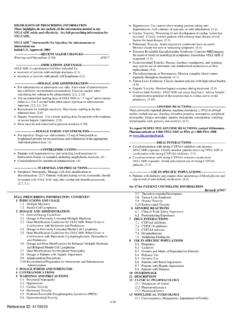Transcription of Understanding your MULTIPLE MYELOMA LAB TESTS
1 This booklet explains common TESTS for patients with MULTIPLE MYELOMA . your doctor uses them to help diagnose and assess your MULTIPLE MYELOMA , and monitor your progress and side ranges in this booklet are adapted from Mayo Clinic Laboratory Test Reference Values. The ranges listed on your report may be different. Contact your healthcare team to address any specific questions you may have related to your laboratory your MULTIPLE MYELOMA LAB TESTS2 Mark the test values in the column below each dateReference ranges Date of laboratory testCOMPLETE BLOOD COUNT (CBC) Pages 4-5 White blood cells (WBCs) 109/L WBCs (neutrophils) 109/L Red blood cells (RBCs)Males: 1012/LFemales: 1012/L HematocritMales: : Hemoglobin (Hgb)Males: g/dLFemales: g/dL Platelets150-450 109/LCHEMISTRY PROFILE Pages 6-8 Glucose, serum (fasting)70-100 mg/dL Blood urea nitrogen (BUN), serum7-20 mg/dL Creatinine, mg/dL Protein, total, g/dL Calcium, total, mg/dL Beta2-microglobulin, mcg/mLSERUM PROTEIN ELECTROPHORESIS (SPEP) Pages 8-9 M spike ( MYELOMA gamma globulin)N/AThis worksheet can serve as a personal record to better understand your lab test results.
2 Reference ranges values that are considered normal in healthy individuals are provided below as guides. Note that ranges vary among laboratories. 3 Mark the test values in the column below each dateReference ranges Date of laboratory testSERUM QUANTITATIVE IMMUNOGLOBULINS (Igs) Pages 9-10 IgG767-1590 mg/dL IgA61-356 mg/dL IgM37-286 mg/dL IgD 10 mg/dL IgEMean= kU/LSERUM IMMUNOFIXATION (IFE) Page 11 IFEN/ASERUM FREE LIGHT CHAIN ASSAY Pages 11-12 Kappa free light mg/dL Lambda free light mg/dL Kappa/lambda free light chain URINE ANALYSIS Pages 13-14 24-hour urine total protein<115 mg/12 hours M spike, urineN/A Urine immunofixationN/A Creatinine clearanceMales: 77-160 mL/min/BSAF emales: 56-131 mL/min/BSAThe laboratory performing the test should provide the associated reference range with the test results.
3 To learn more about each test, refer to the sections inside the booklet. your healthcare team will review your TESTS with you at your next blood count (CBC)A CBC measures the number of red blood cell levels, white blood cells, and the total amount of platelets in the blood. your body produces blood cells in the bone marrow. Since the overgrowth of plasma cells in the bone marrow can crowd out normal cells, leading to low blood counts, blood cells must be carefully blood cells (WBCs)Normal range: 109/L WBCs help fight infections. A low WBC count reduces your body s ability to fight (neutrophils)Normal range: 109/L Neutrophils are a type of WBC responsible for much of the body s protection against infection. Neutrophils are produced in the bone marrow and released into the bloodstream to travel to wherever they are needed.
4 Since a reduced count of neutrophils increases the risk for infection, a neutrophil count must be closely monitored throughout blood cellsRed blood cellsBlood vesselPlatelets5 Red blood cells (RBC)Normal range: male: 1012/L; female: 1012/L RBCs carry oxygen to body tissues. How much oxygen your body tissues get depends on how many RBCs you have and how well they work. A low RBC count, or anemia, can make you have shortness of breath and feel (Hgb)Normal range: male: g/dL; female: g/dL Hemoglobin is a protein in RBCs that carries oxygen in your blood to all parts of your body. Low hemoglobin levels may show that MYELOMA cells occupy too much of the bone marrow and that not enough space is left for the normal marrow cells that produce range: 150-450 109/L Platelets are blood cells that help blood to clot.
5 If your blood has a low number of platelets, you can be at risk for serious bleeding. If your blood has too many platelets, you may have a higher risk of blood blood cellsOxygen binds to heme on the hemoglobin moleculeHemoglobin moleculePlateletsPlatelets form clots to stop bleeding6 Chemistry profileA blood chemistry profile can measure the level of different substances in your blood. Resulting levels provide insight to the function of different organs (kidney, liver, etc) that MULTIPLE MYELOMA and chemotherapy may , serumNormal range: 70-100 mg/dL when fasting Blood sugar, or glucose, is the main sugar found in your blood. your blood carries glucose to all of your body s cells to use for urea nitrogen (BUN)Normal range: 7-20 mg/dL BUN is a measure of the level of urea in your blood. Urea nitrogen is what forms when protein breaks down.
6 BUN levels must be carefully monitored in MULTIPLE MYELOMA patients since too much urea nitrogen in their blood puts them at an increased risk for kidney blood sample is taken for a blood chemistry profileKidneyUreterBladderA blood sample is takenGlucose in bloodExcess glucose7 KidneyUreterBladderA blood sample is takenProtein, total, serumNormal range: g/dL The total level of protein in the blood is measured by a total serum protein test. If the test results show abnormal protein levels, then MULTIPLE MYELOMA , kidney, liver, blood, and other autoimmune diseases may be Normal range: mg/dL All cells need calcium in order to work. The calcium blood test measures the level of calcium in the blood. If high levels of blood calcium are revealed, that may indicate kidney and bone , serum Normal range: mg/dL Creatinine is a chemical waste product of creatine.
7 Creatine is a chemical made by the body and is used to supply energy mainly to muscles. If kidney function is not normal, creatinine level increases in your blood. The evaluation of the BUN and creatinine ratio is an indicator of kidney in bloodLow blood calciumBeta2-microglobulin (B2M)Normal range: mcg/mL B2M is a protein produced by the malignant cells. Although this protein itself doesn t cause problems, it can be a useful indicator of a patient s prognosis (outlook). High levels mean the disease is more advanced and may be a worse protein electrophoresis (SPEP)The way your body fights infection is with antibody proteins (Igs), which are produced by normal plasma cells. MYELOMA is a cancer of the plasma cells in the bone marrow. In MULTIPLE MYELOMA , the plasma cells produce an abnormal protein called monoclonal protein, or M SPEP is used to separate and identify the presence and levels of M protein in the blood.
8 Each type of plasma cell produces only 1 type of electrophoresisSerum proteinsM spikeAlbuminGlobulin9 Serum quantitative immunoglobulins (Igs)To measure levels of the major classes of Igs in the blood, this test detects and reveals an excessive amount of one of the Ig types. Electrophoresis can then determine if this comes from clones of a cancerous plasma range: 61-356 mg/dL IgA antibodies are mainly present in body secretions and are the chief antibodies in the mucous membranes of the gastrointestinal and respiratory tract, and in saliva and tears. IgG Normal range: 767-1590 mg/dL IgG antibodies are widespread in the body. your body uses IgG antibodies to fight bacterial and viral spike ( MYELOMA gamma globulin) A large peak, or M spike, marks large amounts of M protein. The amounts of normal Igs may also 1 2 MULTIPLE MYELOMA 10 IgMNormal range: 37-286 mg/dL your body produces IgM antibodies to help the immune system fight infections.
9 IgM antibodies are found in blood and involved in combating blood infections. They are the first or primary Ig produced following exposure to an level: kU/L These antibodies play a role in allergic reactions and may be found in the lungs, skin, and mucous range: 10 mg/dL or less Normally found in very small amounts, the exact role of this antibody is not yet completely understood. 11 Heavy chainLight chain12345671234567 SPElgGlgAlgM 12345671234567 SPElgGlgAlgM Serum free light chain assaySmaller units called heavy chains and light chains make up Igs. Produced within the plasma cells, these heavy and light chains bind together to form whole Igs. Typically producing more light chains than required, the plasma cells then enter the blood as free light chains. The activity of MYELOMA or plasma cell growth is linked to the amount of free light chains in the blood.
10 The presence of an M protein is consistent with the excess production of 1 type of light chain (kappa or lambda).Serum immunofixation (IFE) The IFE identifies proteins called Igs in blood. Igs are antibodies that help your body fight infection. If the presence of an M protein excess is identified by the SPEP, the IFE will determine what subtype of M protein is present. Too much of the same Ig is usually due to different types of blood cancer. The adjacent diagram represents the different antibody classes (Igs) on an chainsLight chainsLambdaSerum free kappa light chainsNormal range: mg/dL MULTIPLE MYELOMA or another plasma cell disorder may be indicated by increased kappa free light chains and an increased kappa/lambda free lambda light chainsNormal range: mg/dL MULTIPLE MYELOMA or another plasma cell disorder may be indicated by increased lambda free light chains and a decreased kappa/lambda free kappa/lambda ratioNormal range: Abnormal kappa/lambda ratio may indicate excess production of the kappa or lambda light chain due to MULTIPLE 12345671234567 SPElgGlgAlgM 24-hour urine analysisUrinalysis is the physical, chemical, and microscopic examination of urine.











